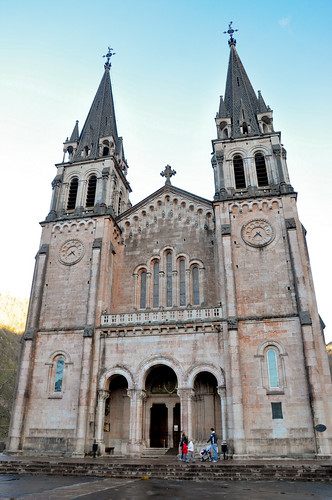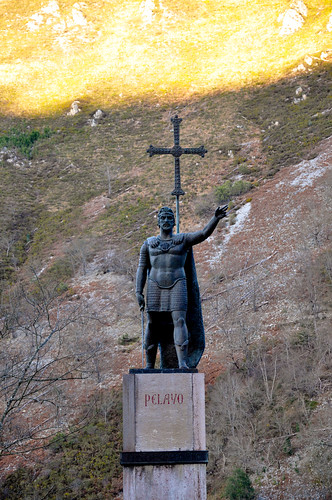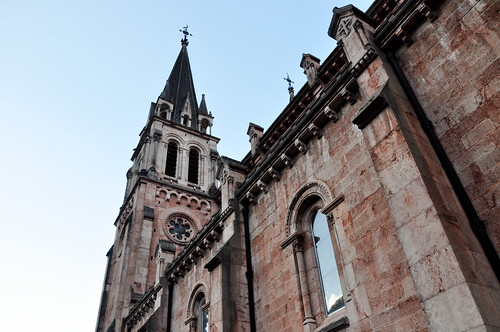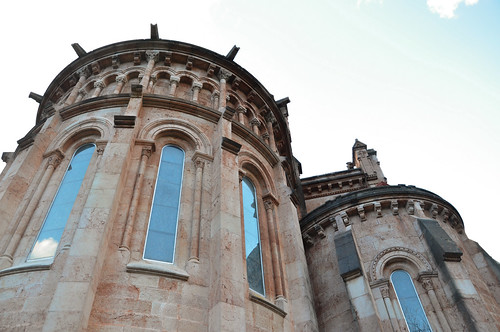
Quinze minutos separavam Cangas de Onís da Covadonga onde chegámos á Basílica de Santa Maria La Real. Aos poucos e enquanto disfrutávamos do sinuoso caminho para lá chegar, ela ia revelando a sua forma.
Não sabia muito sobre este lugar, sabia que é dos mais importantes da história das Astúrias mas faltava o porquê. A estátua em bronze do rei Pelágio (Pelayo) das Astúrias começou a desvendar o mistério que ia na minha cabeça, foi daqui que ele defendeu o seu reino da invasão muçulmana e foi em Cangas que morreu.
Fifteen minutes separated Cangas de Onis from Covadonga where we arrived at the Basilica of Santa Maria La Real. While we were enjoying the view of the winding road to get there, it was revealing it's shape.
I didn't know much about this place, you know that is the most important in the history of Asturias but I missed the reason why. The bronze statue of King Pelagius (Pelayo) of Asturias began to unravel the mystery that was in my head, it was here that he defended his kingdom from the Muslim invasión and it was in Cangas where he died.

I didn't know much about this place, you know that is the most important in the history of Asturias but I missed the reason why. The bronze statue of King Pelagius (Pelayo) of Asturias began to unravel the mystery that was in my head, it was here that he defended his kingdom from the Muslim invasión and it was in Cangas where he died.
Mas a basílica que vemos hoje não é obviamente do seu tempo, nem foi a primeira a marcar o seu lugar aqui nos Picos da Europa. Foi construída no final do século XIX de estilo neoromânico.
A visita é gratuita e não é permitido tirar fotos que na realidade seria complicado ter boas porque no seu interior havia pouca luz. Composto por três naves, o seu interior é simples sem grandes pontos de relevância além das habituais imagens de santos, da Nossa Senhora, etc..
Para mim o importante da visita não foi a Basílica mas sim o lugar em si, a vista que proporcionava e o seu significado. Dizem que ao lutar contra os muçulmanos a Virgem de Covadonga fez soltar umas pedras na montanha que permitiu a vitória do exército liderado por Pelágio e aqui começa a Reconquista.
But the basilica we see today is obviously not from his time, nor was the first to mark it's place here in the Picos de Europa. It was built in the late nineteenth century with a neoromanesque style.
The visit is free and pictures inside are not allowed that would be really complicated to have a good photo inside because there was little light. Comprised of three ships, the interior is simple with no major points of relevance beyond the usual images of saints, the Virgin Mary, etc. ..
For me the important thing was not to visit the Basilica but the place itself, the view it provided and its meaning. They say that when fighting the Muslims, the Virgin of Covadonga made some rocks drop on the mountain that allowed the victory of the army led by Pelagius and here began the Reconquista.
The visit is free and pictures inside are not allowed that would be really complicated to have a good photo inside because there was little light. Comprised of three ships, the interior is simple with no major points of relevance beyond the usual images of saints, the Virgin Mary, etc. ..
For me the important thing was not to visit the Basilica but the place itself, the view it provided and its meaning. They say that when fighting the Muslims, the Virgin of Covadonga made some rocks drop on the mountain that allowed the victory of the army led by Pelagius and here began the Reconquista.

More posts about Covadonga:






Sem comentários:
Enviar um comentário